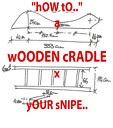..cHRISTMAS bITZ!!
 ..una panoramica su chi
..una panoramica su chiverosimilmente
si litigherà il malloppo alla prossima Sydney-Hobart
pics and txt via xsRacing
Rolex Sydney Hobart Update - Last year Wild Oats XI, the 100ft (30m) canting keel maxi with automatic winches, smashed the course record by over an hour winning the race outright. But this time she will have to contend with Volvo Race winner, Black Betty - ABN AMRO ONE - complete with a hotshot crew of Volvo Ocean racers. Helmsman of ABN AMRO ONE, Rob Greenhalgh explains: Wild Oats was built for this race and because we are racing under the IRC rule, it is unlikely that we can perform as well as we did in the Volvo Ocean Race. In 2001, we had to contend with a huge water spout! Although I doubt that we will keep up with Wild Oats on the water,
 but if we have a big sea state, they may have to back off a little more than we do. Traditionally the race starts with warm air conditions in Sydney Harbour and a beat to Sydney Heads. After reaching the Tasman Sea, it is decision time, stay inshore or go offshore, the right answer is affected by many considerations including the sea state, offshore winds and the east Australian current. Another criterion is where to position your boat on the race course to cross Bass Strait. Bass Straight is notorious for gales, originating from Antarctica. Your angle to the new wind and waves are a key aspect of tactics. Once reaching Tasmania, playing the Derwent River into Hobart is a crucial phase of the race, many races have been won or lost in those last few miles. If any boat can beat Wild Oats XI, then it must be ABN AMRO ONE, and this crew certainly knows how to push to boat to the limit. Story by www.volvooceanrace.org Photo by Jon Nash
but if we have a big sea state, they may have to back off a little more than we do. Traditionally the race starts with warm air conditions in Sydney Harbour and a beat to Sydney Heads. After reaching the Tasman Sea, it is decision time, stay inshore or go offshore, the right answer is affected by many considerations including the sea state, offshore winds and the east Australian current. Another criterion is where to position your boat on the race course to cross Bass Strait. Bass Straight is notorious for gales, originating from Antarctica. Your angle to the new wind and waves are a key aspect of tactics. Once reaching Tasmania, playing the Derwent River into Hobart is a crucial phase of the race, many races have been won or lost in those last few miles. If any boat can beat Wild Oats XI, then it must be ABN AMRO ONE, and this crew certainly knows how to push to boat to the limit. Story by www.volvooceanrace.org Photo by Jon Nashpics and txt via xsRacing
a proposito della quale hanno cominciato a rimangiarsi i bollettini meto-disastrosi..
chissà??
forse anche in Australia i bollettini meteo ad una settimana.. valgono meno delle profezie del mago della Vanna Marchi??

sempre a proposito della Syd-Hob: è ufficiale, correrà anche lei..
lei sarebbe la vecchia signora qui a destra..
ci vorrà più fegato a correrla con la "Maluka" o con uno di quei bestioni basculanti??

Ok.. non è che ci si sarebbe potuto aspettare qualcosa di molto diverso..
..ma un pelo di originalità in più..
da un ex Campione del Mondo Sunfish..
non ci sarebbe stata male!
pics and txt via xsRacing

probabilmente tra i nostri lettori non ce ne sono di esperti e/o praticanti di J boats..
nel senso di J boats di quelle tecnologiche e veloci.. ossia tutte eccetto il J24..
quindi delle dritte sul come far camminare un J-non-J24 potrebbero non servire..
però ci sono i lettori statunitensi..
..magari a qualcuno di quelli torneranno utili..
..e poi la foto di fianco non era male!
pics and txt via xsRacing
Sailing Tips From the Experts - Here are some basic sailing tips from someone who knows a how to make a J boat sail faster - Jim Johnstone. 1) Make sure your bottom is scrubbed. You can have the best sails and crew but a foul bottom can ruin your day. 2) A practice set before racing can save you a lot of screaming and hassle on the course. When the spinnaker comes into the boat from practice make sure it comes in cleanly to be ready for the next set. 3) Create a standard routine...when you get to the boat, when you get to the race course, how you prefer to start, how you call out a tack, how you let crew know your intensions. Steady routines will pay large in much better crew work. 4) In models with large sail plans like the J/109, J/124, J/122 and others that tend to power up in lighter air it's important to twist off the top of the main to de-power the boat and keep the speed and point at the same time. Most small boat sailors struggle in breezy conditions in larger boats because they tend to keep the leach too tight in the main. 5) When considering crew work consider that you only have three crew. Everyone else gets assigned to one of the three. This helps reduce your desire to micromanage the entire crew. 6) The J/105's are underpowered in light air with class sails. Don't pinch. Trim the jib with the lead farther foreword and center the boom without much twist in the main and foot more then point. 7) Tack lines are a great steering indicator for racing an asymmetrical sailboat. If your tack line is eased the driver should keep the tack vertical at all times. If the tack goes to windward you are heading too low. If the tack goes to leeward you are over sheeted or too high. This works on moderate weight asymmetricals. Very light sport boats the technique is different. For more tips on sailing your J-boat fast go to www.jboats.com
pics and txt via xsRacing
Chiudiamo con due perle consumistiche ed una spirituale!
Le perle consumistiche sono dedicate al pubblico femminile.. nel probabile caso in cui qualcuna si debba far perdonare l'ennesimo "maglione-natalizio"


..qualche delucidazione alla potenziale acquirente conviene darla..
vanno bene entrambe, o l'uno o l'altro..
se quello che si è beccato il maglione-natalizio, quando va in barca d'inverno, mette nella sacca una muta di neoprene (o di qualsiasi altro materiale) allora potrebbe gradire più l'opzione più a sinistra, quella con i disegnini..
se mette nella sacca una cerata, forse meglio l'opzione di destra, quella col tizio con gli ochiali scuri..
..in ogni caso: non ci sono donnine discinte, e gradirà il pensiero tanto da soprassedere anche sull'ennesimo maglione..

se trovi le dimensioni dei pistoni piuttosto inverosimili..
devi andare a vedere le dimensioni di ciò che li contiene..

il cielo a 19000 piedi
per l'esattezza dalla vetta dell' Ojos de Salado

che è uno stratovulcano
(foto sopra)
il più alto tra quelli attivi sul pianeta
proprio sopra il deserto di Atacama
in Cile..
chiudiamo con una perla natalizia, faceta ma non troppo, sulle mistificazioni sulle celebrazioni natalizie, che certi tizi in gonnella con una latente e insalubre attenzione x i ragazzini, hanno messo in giro negli ultimi quindici secoli.. circa..








































0 Comments:
Post a Comment
<< Home